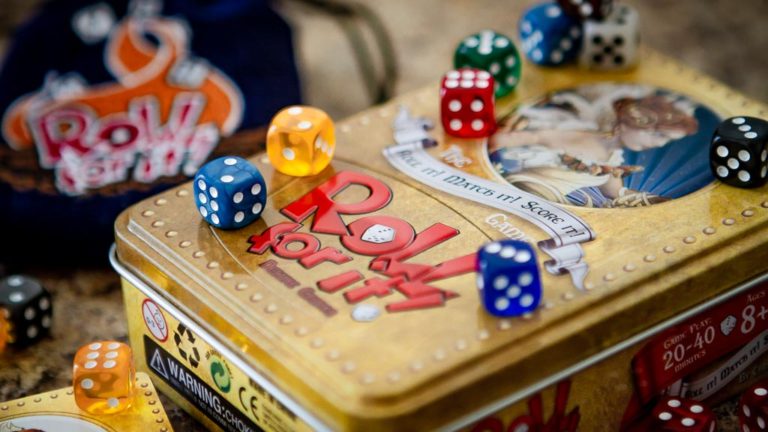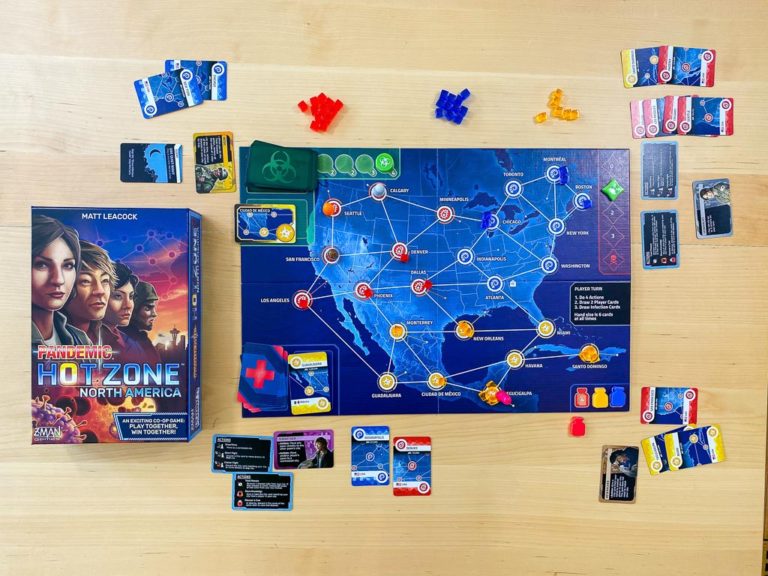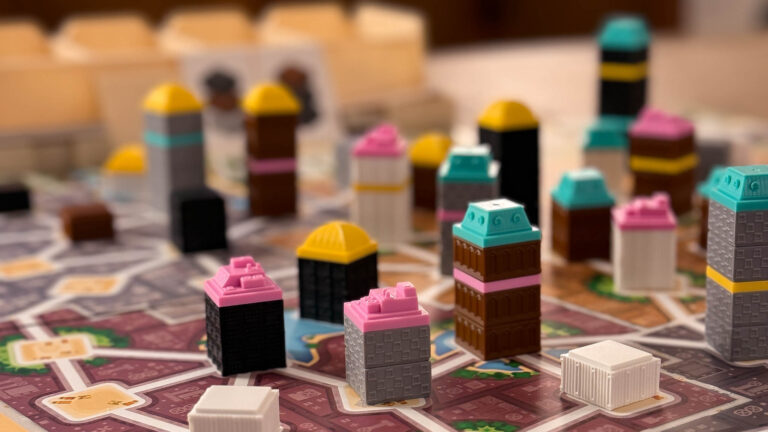Get ready to embark on a journey to discover all the secrets in Charterstone!
You and your fellow players are tasked by the Forever King to colonize and build a prosperous village!
Charterstone gives players a unique gaming experience where you will build and change the game over the course of your 12 game campaign!
Before we jump in with explaining how the game works and our thoughts, I want to say that because Charterstone is a campaign game, there are inherently some spoilers that will be viewable in some of the images if you examine them closely. I try to keep my thoughts on the content of the game relatively spoiler free, but please know that in an effort to give you our thoughts there are a few small spoilers mentioned.
If you do not wish to be spoiled in any way, skip down to our Final Thoughts.

What is Charterstone?
Charterstone is a worker placement campaign* game where players will build up a shared village over the course of 12 games. Each game they will unlock new buildings, meet new goals, and even add new rules to the game.
The game itself starts off very simple with players having limited choices. As the game progresses, so too does the difficulty of the game as the players add more and more to the board increasing their options and paths to victory.
* A campaign or legacy game is a board game where the rules and components change throughout play based on the decisions of players and outcomes of each game. Physical and irreversible changes are often made to the board and cards themselves.
How do you play? Here’s a Brief Overview!
When you begin your first game of Charterstone, one of the first things you’ll probably notice is that the rulebook is incomplete. Only a handful of rules are provided while there are a total of 29 spaces for rules in total! As you play you’ll be adding more and more rules to the game.
Charterstone is a worker placement game. The goal is to earn the most victory points each game. You do this by placing your workers on action spaces on the board which generate an effect.
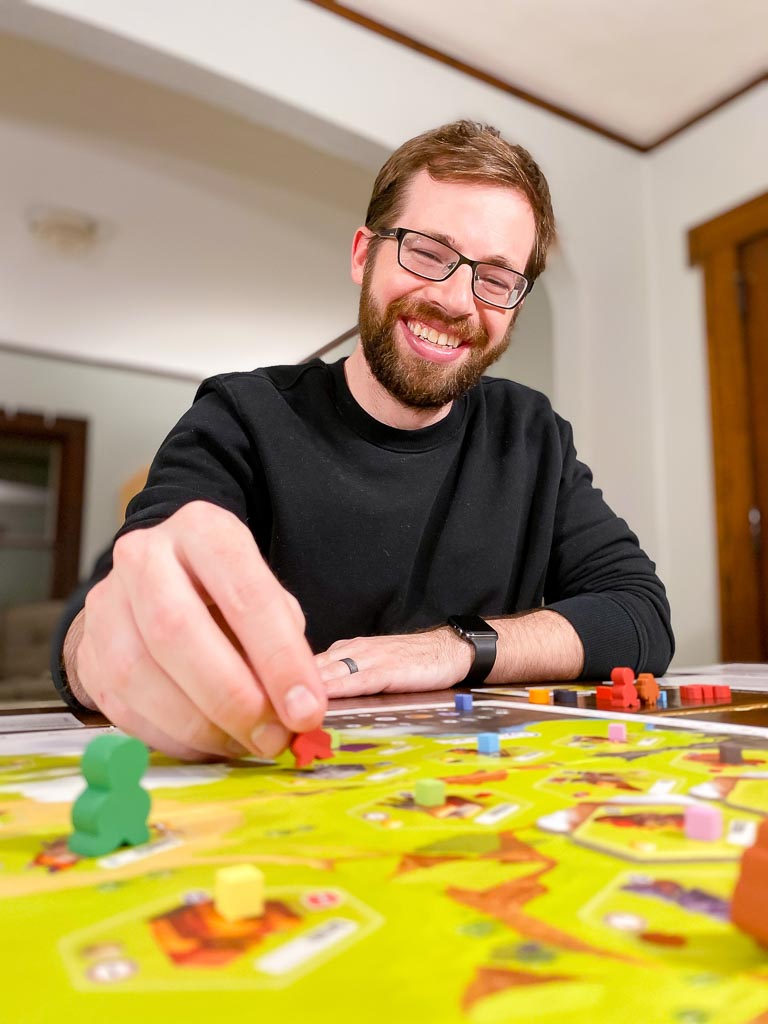
On your turn you have two options. You can either place one of your workers or you can retrieve all of your workers.
Each player has their own charter, this is a space on the board with 6 spaces where players will build new buildings when able. Any player can visit a building in another players charter, but only the player of that charter may build there.
In the center of the board is The Commons. These are permanent spots where players will be able to score objectives, gain cards, earn money, construct a building, or open a crate all by paying the appropriate cost.
Each game involves players taking their turns again and again one after the other until the game’s end. When the players use The Commons to construct a building, open a crate, or score an objective the game’s progress tracker is moved forward one space. When it reaches the end of the track the game ends and the player with the most victory points is the winner of that game.
After the first game, guide post cards will be added. These give players an objective and special rules for the specific game players are playing. Each game will have their own unique guidepost card and players who achieve the guidepost get to scratch off the box and choose the direction the town goes in next.
How do things change?
Writing on Cards. (self explanatory)
Building Buildings: When constructing a building, you will remove the building’s sticker and place it on an unoccupied location in your charter, or on top of another building in your charter. These are permanent and once placed cannot be removed. The card the sticker was on then becomes a crate that you keep and place into your player area.
Opening Crates: When you open a crate, you’ll consult the index. This is the box that holds all of the cards players must unlock. Follow the guide to know which cards you can remove.
Opening Boxes: There are a few boxes that hold secret materials that players are not allowed to open until they have unlocked them.
Other exciting ways that I can’t explain without spoiling it for you!
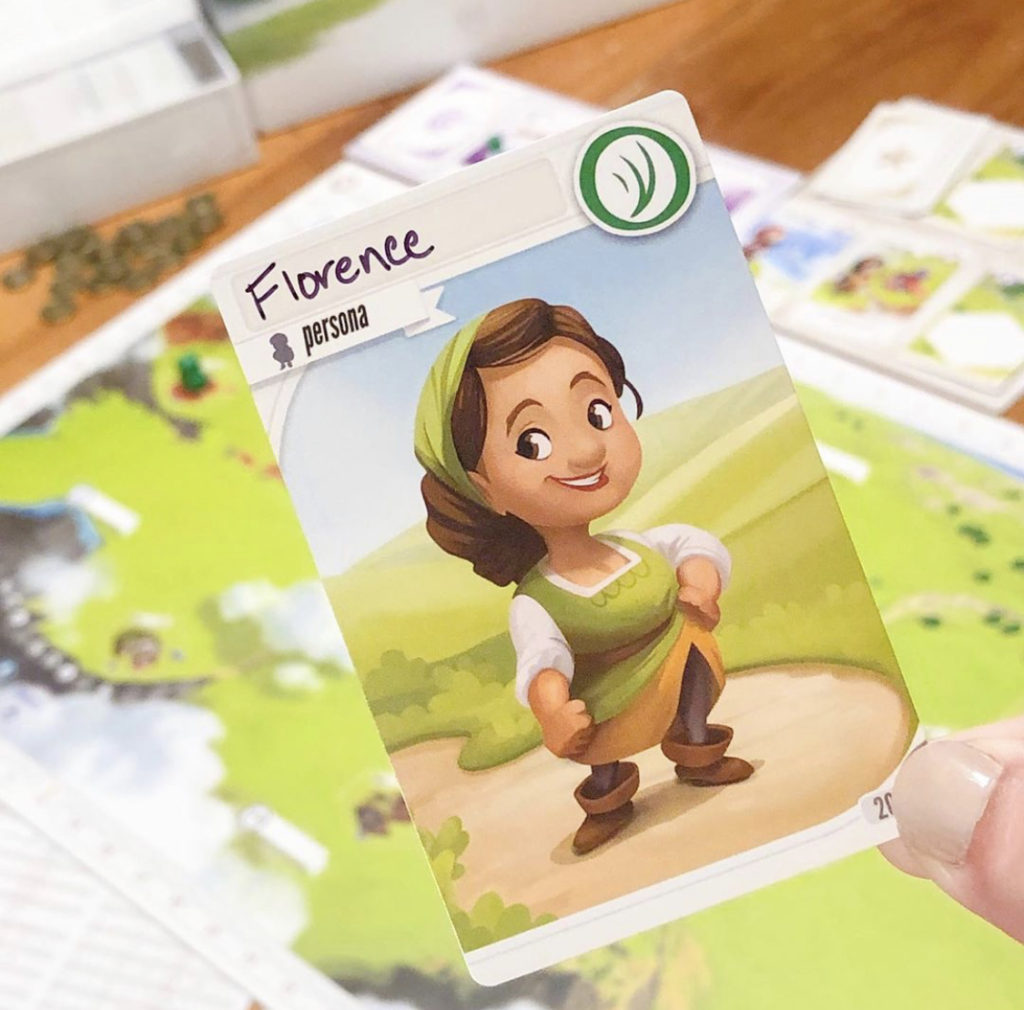
What do we think?
Charterstone is a gem.
We had a lovely time playing our way through this game. I myself greatly enjoyed working towards the various goals provided to players through guidepost cards and trying all of the new ways to use the buildings in the town. Gathering resources, building buildings, opening new crates, and using the town to its fullest potential was very satisfying.
With each new game of the campaign we loved the thrill of discovery as new things were unlocked and secrets revealed. There were more than a couple “Ooooh! How cool!” moments.
While the game begins fairly simple with very few options, it quickly becomes filled with new buildings, cards, and items that gave us more and more avenues to take to meet our goals.

One drawback of this is that once the board is full, Charterstone can definitely look overwhelming, especially for players that tend to struggle knowing where to start. At the beginning of a new game, it can be hard to formulate a strategy for yourself and what you are going to spend your game working towards.
In Charterstone there are 42 locations to choose from and many do similar things. While I sometimes find games with a huge array of action options a bit paralyzing, especially for new players, I did not find Charterstone this way.
One of these reasons is the guidepost cards. These are incredibly helpful not only in providing variety for players in each game, but for literally providing a guide to those who struggle to know what they should do. I was always very happy for the guidepost cards to help me in this area as they also aided in making us stretch our comfort zones. It can be easy to get into a strategy rut of knowing what plan works and then not deviating too far from that, but these helped us try new things and use the board in new ways.
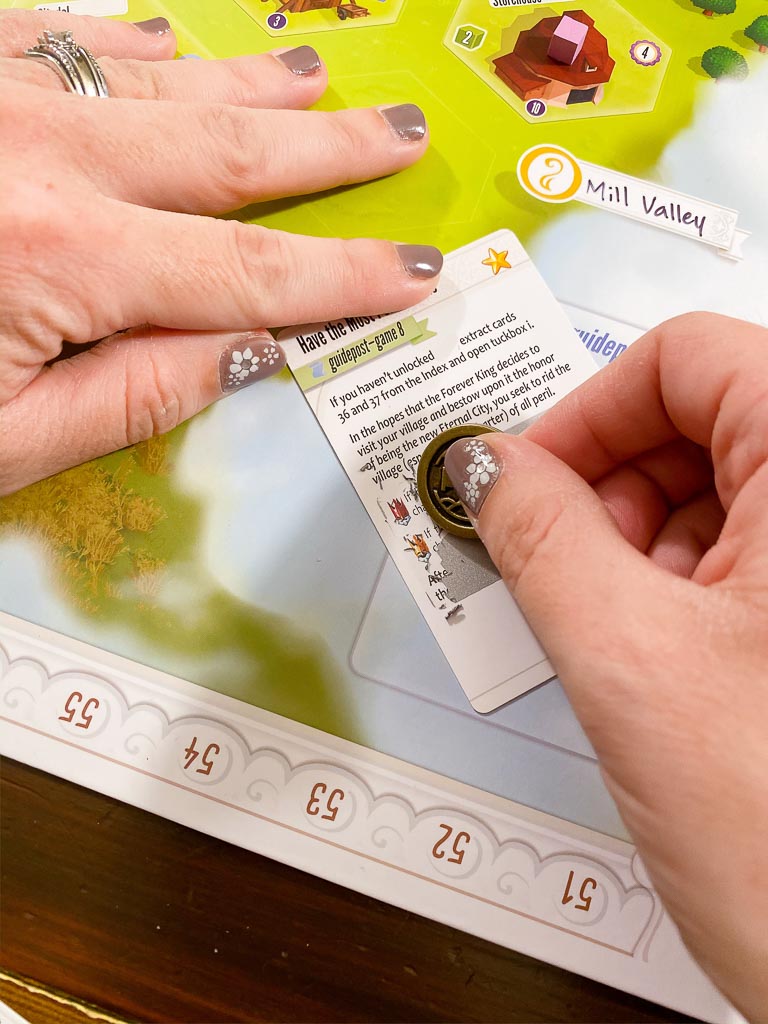
The other reason Charterstone wasn’t paralyzing is because you slowly work up to a full board. Often you are choosing which buildings to add to the game, contemplating what help they’ll provide you and how often you’ll use them. This gives you a bit of an advantage in learning the game because you are having a hand in creating it. You probably won’t use every location, but I find myself to explore different strategies more confidently in Charterstone than in other games where I might stick to more proven paths.
Now I will say, as you unlock more crates you’ll also be given more rules. We did have to continually check the rules for clarification, especially in the beginning, because they kept changing so it took a little more time to figure it all out.
That being said, this is much more of an issue for the front half of the game than the back. And even when you need to double check a rule, it is very easy to find it in the rule booklet and we found them to be very clearly explained.
Theme
For a game where you are constantly building and expanding your board, the theme of building and constructing buildings to colonize the land and build a prosperous village is juuuust about the most perfect fit.
The many and varied buildings you can build throughout the game all function in ways that you would expect. Head to the Forest to gather the wood resource, then take that resource to the Wood Market to sell it for a coin and increase your Reputation as a master woodsman.
The story builds through all 12 games, adding to the overall theme. While not particularly necessary, it is fun at the end of the campaign to go back through and read the story of your village in full.
Components
The components are fantastic. It’s a very well designed game. I found the stickers to be very easy to apply to the board and once there they blended seamlessly with the design. Similarly we really enjoyed the sturdy tuck boxes and all of the internal storage compartments to help players keep their items separated from game to game. The Index was very easy to use and made finding the cards you needed once unlocked a breeze.
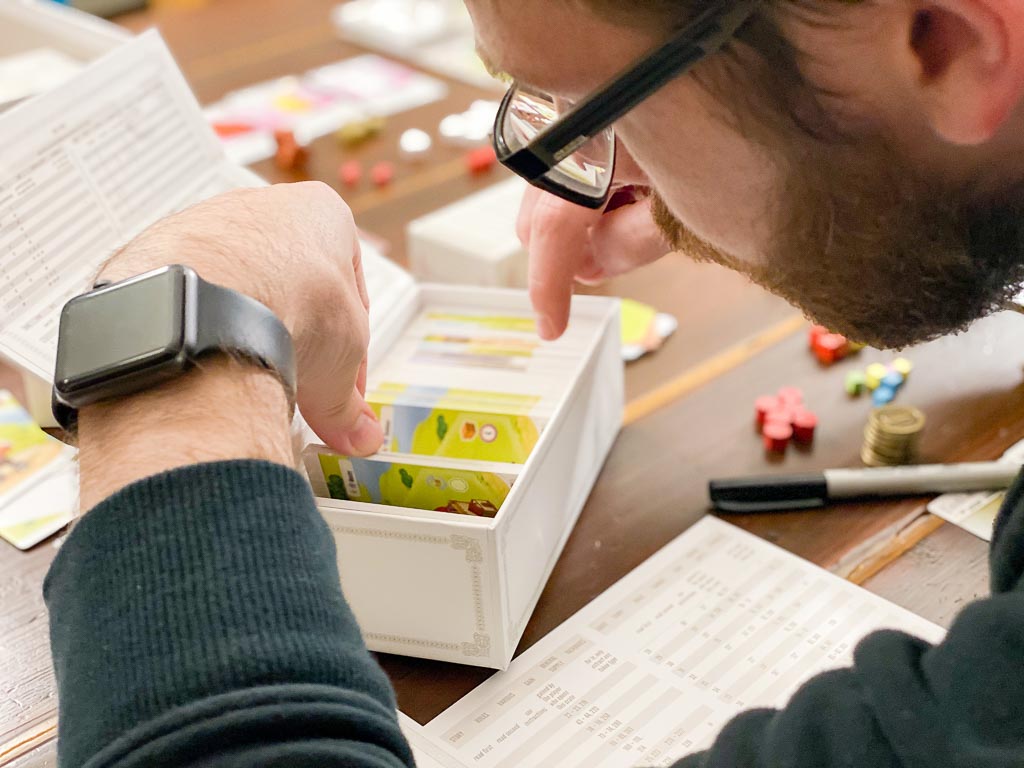
I also love that the board comes double sided! After playing through your campaign, you can purchase a recharge pack to play through another campaign without needing to buy a whole new game.
Alternatively, you could also get the recharge pack to fill the second side of the board with your favorite buildings that you discovered during the campaign that might have gotten covered up during the course of play. Adam thought this would be a fun way to design our own version of Charterstone now that we had played through the campaign and the thrill of discovery would be gone.
No matter what you choose, I love that you’ll still have a unique playable worker placement game at the completion of your campaign.
How does it play with two?
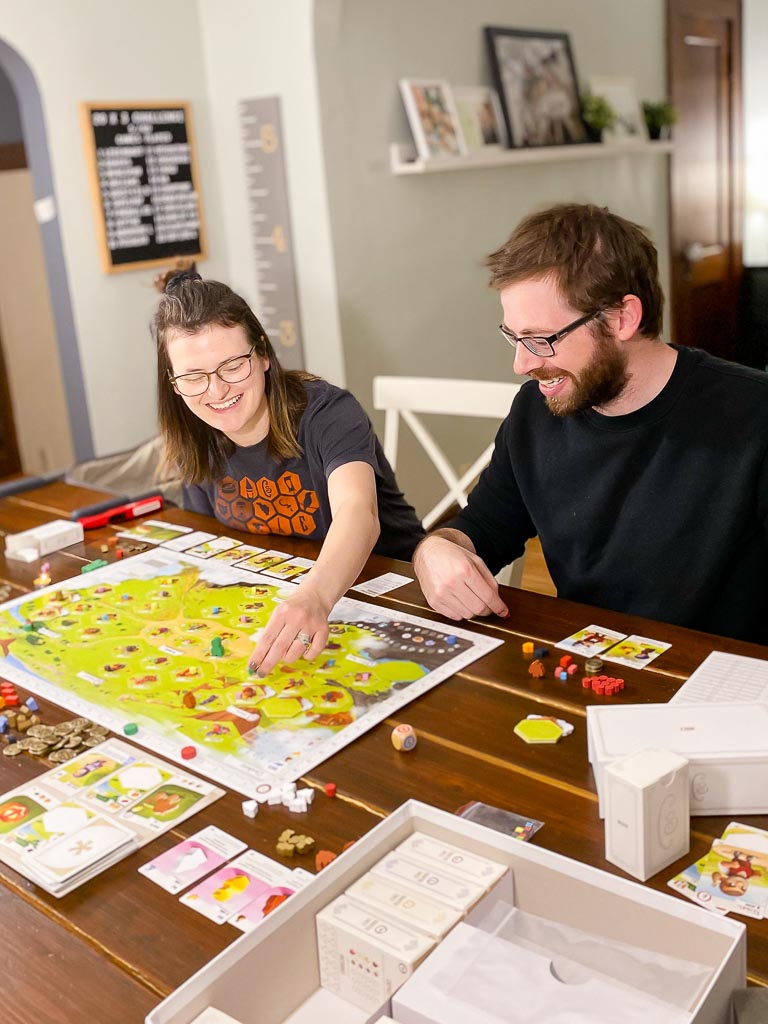
I think Charterstone plays great with two except for one particular area: it takes much more time to unlock items and add things to the board with two players. This doesn’t diminish the game itself, but does mean that you might take till game 5 or 6 to unlock something that you could have gotten earlier if you were playing with even 3 or 4 players.
For us, trying to play this with a full player count wasn’t workable. We just don’t have a game group that could meet 12 times in quick enough succession so that we would not only be able to finish the game, but not forget the every changing rules in the time between play sessions.
We got Charterstone simply to enjoy as a date night game and I found it completely delightful. There are special rules in the booklet that show how you can play two players and include some Automa (fake) players but you do not have to do this and can play, like us, with just two characters total and follow those instructions.
Each game took us about 30-45 minutes so we were able to play two games back to back most nights, making the 12 game campaign manageable and not as daunting.
Can kids play?
Probably not, at least, not young kids. This becomes a pretty sophisticated worker placement game rather quickly. The more you unlock and the more rules you add the more complicated it becomes.
It can also be a bit overwhelming to know where to go and what strategy you want to employ to earn victory points. This would all be too much for most any player under 10 years old.
The box recommends 14+ which is probably correct if wanting to play on their own without an adult. If you’ve got younger kids that want to play with you, I would recommend players be nearing 10 or older with some decent gaming experience under their belts. We got the recharge pack and look forward to playing it with our daughter (8) in a year or so.
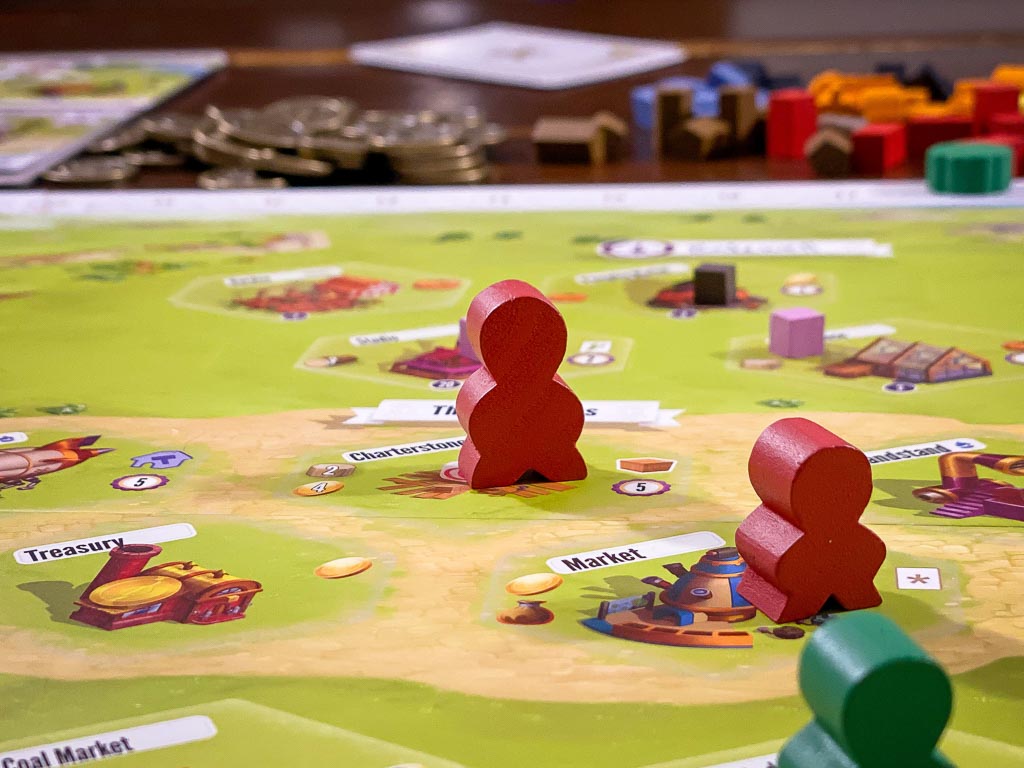
Final Thoughts
Charterstone is a very fun and unique take on legacy style games. Stonemaier Games provides players with another interesting and challenging experience that is full of fun surprises to discover as you unlock and build your village along the 12 game campaign. Players are able to build the game to their liking, customizing it nearly from top to bottom.
Packed full of beautiful artwork and high quality components, it’s a treat to look at as well as play.
Players who struggle with analysis paralysis may become overwhelmed as the game progresses, but Charterstone does a nice job of easing players into it by giving them full control of what to build and slowly adding rules and new elements.
We played through the entire Charterstone campaign with just us two and found it to be wonderful and did not feel like our experience was negatively impacted by not playing with a larger group.
This is a great option for families with teens/preteens to play through together or as a date night game. And, unlike other legacy games, once you are through with your campaign, you will have a unique worker placement game that you can continue playing again and again.
We highly recommend Charterstone! To purchase your own copy, head to Stonemaier Games, or our Amazon Web Store.
Digital App
Bonus! While writing this review the iOS version of Charterstone came out for iPhone and iPad. I downloaded it and gave it a try. This is a great medium for Charterstone and will delight any fan of the game.
I love being able to play through a campaign solo with AI players while still having all the fun of customizing and building my village as I’d like. There’s also the option to play online which makes it a great choice for folks who may want to play together but live far apart.
That being said, if you’re at all interested in playing Charterstone for the discovery found in the campaign, I 100% recommend playing through the board game first.
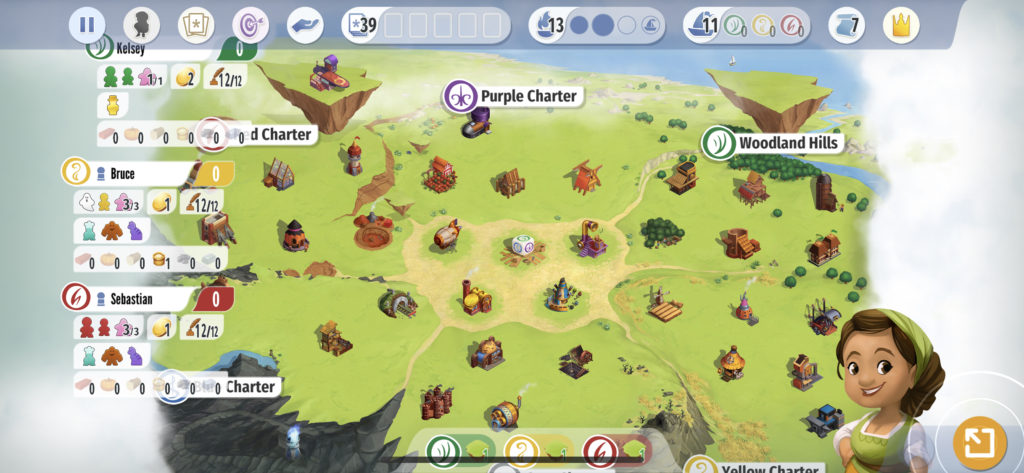
Game Info:
Title: Charterstone
1-6 players Ages 14+
Designer: Jamey Stegmaier
Artist: Lina Cossette, David Forest
Publisher: Stonemaier Games
Published: 2017
If you liked this post you may also like:
10 More Great Date Night Games
Tapestry Review
Wingspan Review


